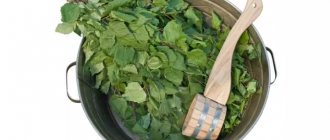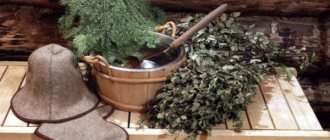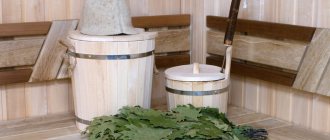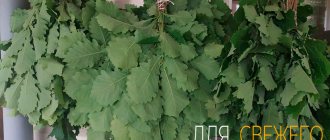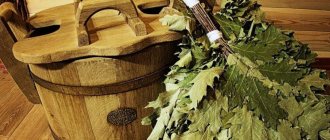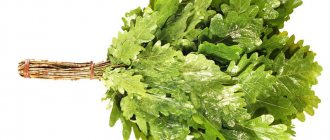Last time we talked about a broom made from birch shoots. Such a tool is good for everyone, but under conditions of active work, it happens that the birch tree begins to lose its leaves. For true connoisseurs of a vigorous Russian bath, an indispensable item in a steam room is an oak broom. Diligent soaring on the top shelves is just about him.
Oak - how much there is in this word
Among the ancient Slavs, oak was revered as a sacred tree and was dedicated to the head of the pagan pantheon, the god of thunder and lightning - Perun. A powerful crown, dense wood, and a deep root system very often provoke the fact that a spreading tall tree simply attracts thunderstorms, and if so, if Perun loves it, then people are simply obliged to honor it. Often Slavic settlements in forested areas were located on the edges of vast oak groves. The light energy of this tree provided the spiritual needs of the family, and the wood met the material needs. Still would! She is good in the hearth, and in construction, and in carpentry, and even in crafts. And today, in the age of high-tech polymers, oak provides a lot of humanity’s needs in a wide variety of areas:
- Oak construction and semi-precious timber is very expensive, but at the same time, a favorite position for carpenters and joiners. Dense solid wood, beautiful texture, developed texture make the wood of this tree in demand at all stages of construction: from laying the main crowns of the bath house to finishing the dressing room with blocks. As for bog oak, not every craftsman can drive a nail into its face - its surface is so strong and unyielding, its characteristic blue-black color;
- Oak acorns are a favorite delicacy of pigs and, oddly enough, gourmets. Yes, some connoisseurs prefer a drink made from acorns even to real coffee, rather than barley or chicory coffee;
- Oak bark is a source of tannins. And if earlier this feature was used by tanners, now it is mainly used by pharmacists. Oak bark is very effective in stopping bleeding in the oral cavity, strengthening the gums, and the walls of blood vessels as well;
- A strong decoction of oak bark can nobly color wood of less valuable species, giving it exquisite charm and depth of visual perception, and ink nuts provide raw materials for the preparation of universal dyes that will color everything: from paper to fabrics;
- In the southern regions of the country, cork oak is feeling more and more confident. Its developed subcortical layer is an indispensable natural raw material for wine and cognac bottles;
- Finally, oak leaves are a very valuable additive when preserving cucumbers. Knowledgeable housewives claim that the presence of oak leaf in the seasoning gives greens hardness, elasticity, and vigor. A truly crisp cucumber can only be achieved with an oak seed at the bottom of the jar.
What is the value of oak in a bathhouse?
Oak and bathhouse
As we have already said, oak wood is the most valuable raw material for construction and ornamental timber. However, not every owner will be able to afford to build a bathhouse on his property from solid oak blocks or decorate a recreation room with panels made from this noble wood.
In the oven
Also, not every owner of a steam room will allow himself the luxury of heating a stove exclusively with oak logs. Although, oak is exceptionally good in the oven:
- Its wood has a high calorific value.
- The logs burn with an even, moderate flame and practically do not shoot sparks, like the same spruce firewood.
- It's a pleasure to split oak. Yes, cutting it across the fibers is not an easy task, but lengthwise, even with little effort, it pricks well, and being well frozen, one might say, it’s even fun.
- Oak is not inclined to clog chimneys with soot plugs, the fight against which is a very unusual matter. Even when not completely dried, it does not produce soot as much as other tree species, especially conifers.
- Finally, heating the bathhouse with oak wood immediately creates an indescribable atmosphere of some special comfort and an amazing spicy aroma. Yes, of course, it’s nice to heat a sauna with birch, alder, and fruit logs, but oak is damn good in its own way. Anyone who has used it will definitely confirm.
And in the steam room
Let’s now consider why the oak broom seduces users, at least in comparison with its direct competitors:
- Due to the abundance of leaves, the size and density of the leaf blade, such a broom is excellent for controlling the “steam cake”. In German baths, and the Germans understand a good bath no less than they understand good beer, it is customary to “conduct” the steam with an oak broom, which, despite its fairly compact size, due to its special fan-shaped shape, performs its function to all twelve points;
- It is very durable. It is not uncommon for particularly zealous owners to have a well-made oak broom that lasts five or six trips to the bathhouse. From our point of view, reusable use of a tool is not entirely correct, but this example illustrates the essence and capabilities of oak more than perfectly;
- Oak broom is very fragrant. Well steamed, it incomparably aromatizes the atmosphere of a steamy room, where some synthetic aromatizers go;
By the way! According to some experts, the aroma of a steamed oak broom acts as a deterrent to the rise in blood pressure, especially when taking steam procedures with high ambient temperatures.
- An oak broom is preferable for users with oily skin. Oak leaves contain a large amount of tannins and are able to combat the increased secretion of the sebaceous glands. In addition, village healers used a decoction of oak leaves to combat excessive sweating of the feet. Oak therapy is also good as a restorative for chronic muscle fatigue. It is not for nothing that Volga barge haulers preferred oak during bathing procedures.
Cold method
From a medical point of view, this method of steaming a bath broom is considered the most correct.
Necessary:
- Take a deep container so that the broom is completely immersed with the leafy part in the water.
- Pour cold water, it’s good if there is melted water.
- Soak the broom for 10-12 hours, leaving it in a cool room.
After 12 hours, you will have an almost freshly cut bath broom in your hands, with which you can conveniently and pleasantly spend time in the bathhouse. The leaves will resume their natural color, and the branches will regain their flexibility and elasticity.
Advantages:
- Preservation of all beneficial properties of birch leaves
- The elasticity and resilience of the branches, which does not cause unpleasant sensations when exposed to the body
- Preservation of healing essential oils that are released at high temperatures
Source
Procurement: timing and features
You can cut oak shoots as raw materials for brooms from the second half of June until mid-August. It is at this time that the maximum amount of useful substances is concentrated in the plant, and the leaf blade itself, together with the petiole, is able to resist maximum loads.
A word from Experienced! The most widespread species in our latitudes is pedunculate oak. Harvesting of shoots must be carried out in dry, clear weather, immediately after the dew has disappeared, in the first half of the day. Preference should be given to young, even branches with maximum stem flexibility. Such characteristics of raw materials can be provided by trees that grow on moist, but not swampy soil. The oak companions here are buckthorn, euonymus, lungwort and European hoofweed. The most valuable shoots are produced by the everlasting oak tree. The foliage on such a tree remains on the branches in winter and is gradually destroyed. It is these leaf blades that are most resistant to mechanical stress, which is fundamentally important for a broom.
Cut shoots are sorted, discarded and placed for drying in a shaded, well-ventilated place. 7 - 8 days is enough to lose excess moisture. After this, you can form the broom as such. At the same time, generally accepted rules are followed: thick shoots are used as the base, thinner ones at the edges, the handle is shaped for a comfortable individual grip, a diameter of 5 cm is sufficient in most cases. If you are sure that the preliminary drying was carried out efficiently, then the broom can be purposefully shaped into a fan, loading it evenly over the entire plane with a small weight. The broom ripens and is stored in a dark, dry room.
Rules for collecting oak branches
Oak is a majestic plant that contains essential oils and tannins. To preserve all its beneficial properties, you need to know how to prepare a fresh oak broom.
The suitable time for collecting oak branches is July and August with calm and clear weather. During the autumn months, wood is fragile and brittle. The gathering place is a dark mixed forest or oak grove. You should not collect from single trees in the park. They have small leaves and stiff stems.
Choose trees no more than 4 meters high, but be prepared that you will have to climb to the top. Good, elastic rods are rarely at arm's length. The cut branch should be good, strong, wide, have branches and a rich green color. The optimal length is 50 cm. To avoid harming the tree, cut only the side shoots with garden pruners.
Oak branches can be diluted with medicinal plants, for example, yarrow, sage, wormwood, oregano or nettle. They will enhance the healing effect on the body.
When knitting, small twigs are laid offset. The design resembles a fan connected with twine. Do not use a large number of branches, otherwise the product will turn out heavy. Once assembled, place the finished steam room accessory under pressure to give it a flat shape.
Using an oak broom
The use of a broom is preceded by its preparation. Just dip a fresh broom in warm water and rotate it in the tub for a few seconds to wet the surface of the leaf. As mentioned above, the key difference between an oak leaf and a birch leaf is that leathery oak leaves do not absorb sweat, but simply remove it from the surface of the body. Therefore, logically, an oak broom should be moistened in warm water more often during the steaming procedure. Brewing a fresh leaf in boiling water will provoke a violation of its structure, will not allow it to perform its function normally, and finally, this will affect the durability of the leaf blade and the integrity of the broom as a whole.
A dry broom is also first dipped into water, but this is not enough to bring it into working condition; a more effective activation of the tool is necessary, primarily with water and elevated temperature. It looks like this:
- Briefly immerse the bundle in warm water to rinse it.
- Transfer to a tub of cold water for 3 - 4 minutes.
- We return it to a container with moderately warm water, approximately 50 degrees Celsius, and let it stand for another 3-4 minutes, after which we add an equal amount of boiling water. We keep it in this heated state for 8 - 10 minutes. At the same time, it is useful to cover the container with a lid for better effect.
- To enhance the aroma, practitioners advise holding a broom over the stove stones for several seconds. This will help get rid of excess and useless moisture.
Important! An indicator that the sheet is oversaturated with water is its increased stickiness. This situation can be partially corrected by heating a broom over a hot heater.
Bath gourmets, however, use a longer, but also much more effective method of preparing a broom for use. It consists of soaking a dry broom in cold water overnight, and then, wrapped in a linen towel, placing it on the top shelf of a heated steam room for a few minutes.
Steaming methods
There are many ways to steam an oak broom for bathing procedures. Each of them has its own characteristics.
- Basic. This method is used by most fans of bath procedures using an oak broom. This method involves steaming only a well-dried, durable broom made from elastic oak branches with abundant foliage. Initially, it is placed in a bucket of clean cold water for half an hour, after which it is transferred to a bowl of hot (but not boiling) water for 5 minutes. It is important to use a broom steamed in this way for bath procedures until it has cooled down. Cold oak branches lose their aroma and elasticity.
- Long. This method is usually used to soak very dry oak brooms, which begin to crumble under the influence of boiling water. They are soaked for 10-12 hours in cool, clean water until the foliage is completely softened. In this case, no additional treatment of the broom in hot water is required.
- Express steaming. This method is usually used in conditions of acute lack of time, when no more than 20-30 minutes remain before visiting the bathhouse (steam room). In this case, a dry bath broom is placed in an enamel basin, filled with boiling water and covered with a lid or a metal container of the same diameter. The broom should be kept in boiling water for 10-15 minutes, after which it should be used for its intended purpose.
- Express steaming in a steam room. This method is often used for steaming very dry and brittle oak brooms. This procedure is performed directly in the steam room of an already melted bath. In advance, in a steamy room, prepare a basin with cool, clean water, into which a broom is immersed for 1-2 minutes. Then the broom is moved towards the hot stove stones, holding it over them for 1-1.5 minutes. During this time, drops of cold water falling from the leaves onto the hot stones will turn into steam, due to which the broom will quickly soften and become suitable for use.
- Popular. This method is used for steaming hard oak brooms with firmly planted foliage. They are steamed several times, periodically changing the water. The first time they are steamed with boiling water, the second and third time - with hot, but not boiling water. The entire procedure usually takes no more than 40-45 minutes.
- Classical. This method is considered a little time-consuming, but it is what allows you to get a perfectly steamed, soft and fragrant oak broom. To do this, you need to soak a dry broom for 8-10 hours in water at room temperature, then wrap it in damp gauze and place it on the top shelf in a heated steam room. After 10-15 minutes it can be used for bath procedures.

